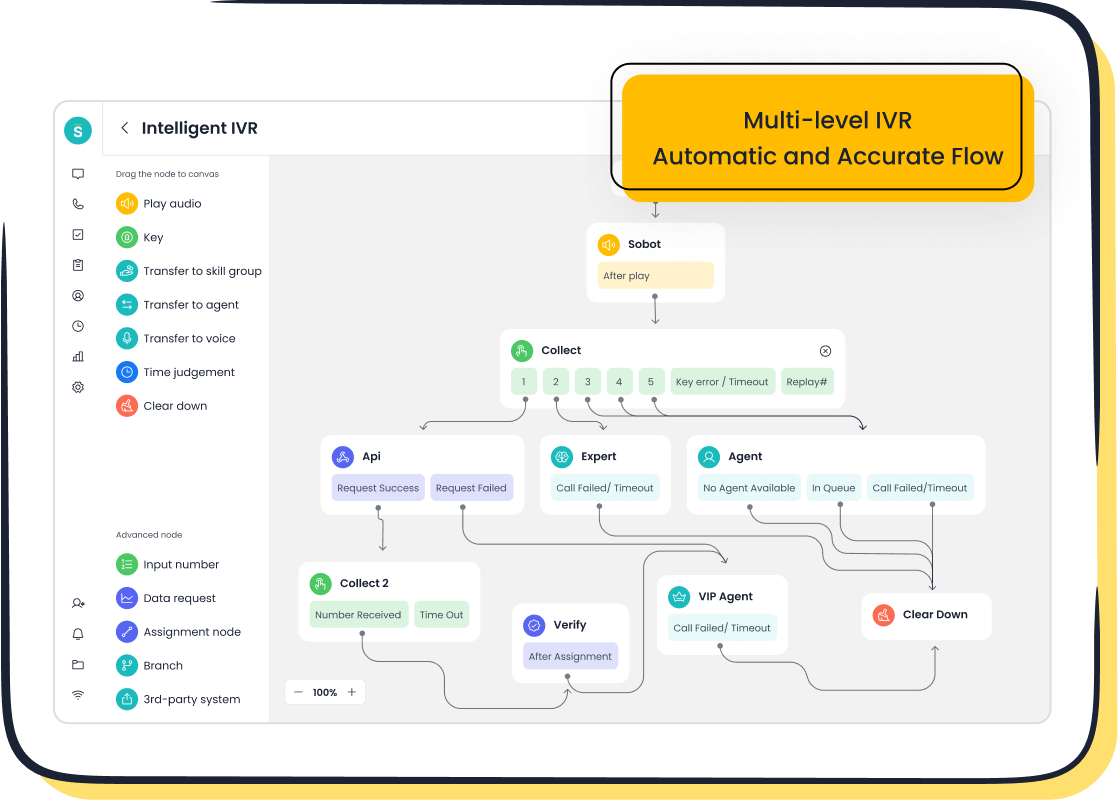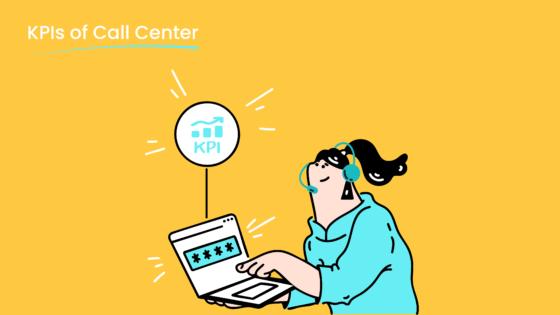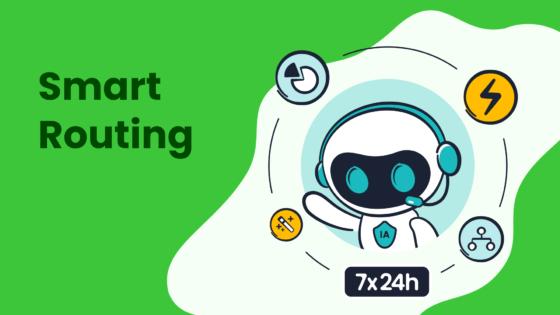What Are Inbound Calls and Why They Matter in 2025

Inbound Call Management refers to the process of handling customer calls made to businesses when individuals need help, have questions, or seek assistance. These calls are the backbone of customer service, providing a direct way for customers to connect with you. In recent years, the demand for inbound support has grown significantly. For instance:
- Inbound voice calls rose to 55.4% in 2023, up from 53.5% the previous year.
- Voice support remains the go-to method for resolving complex issues.
By 2025, customer expectations will push businesses to deliver faster, more personalized service. People want immediate responses and a human touch, even in a tech-driven world. Tools like Sobot's Voice/Call Center make managing inbound calls seamless, ensuring you meet these rising demands while keeping your customers happy.
Understanding Inbound Calls
What Are Inbound Calls?
Definition and primary functions of inbound calls.
Inbound calls are customer-initiated phone calls made to businesses when individuals need assistance, have questions, or seek support. These calls are a vital part of customer service, offering a direct and immediate way for customers to connect with your business. Whether someone is troubleshooting a product issue or asking about a service, inbound calls provide a human touch that other communication channels often lack.
The primary function of inbound calls is to address customer needs effectively. They focus on resolving issues, answering inquiries, and providing guidance. For example, a customer might call to clarify billing details or to check the status of an order. These interactions not only solve problems but also create opportunities to strengthen customer relationships.
Examples of inbound call scenarios (e.g., customer support, product inquiries).
Inbound calls occur in various scenarios across industries. A healthcare provider might receive calls from patients seeking appointment details or medical advice. In e-commerce, customers often call to track orders or inquire about return policies. Similarly, financial institutions handle inbound calls for account-related questions or technical support.
Here’s a quick look at industries that rely heavily on inbound calls:
| Industry | Use of Inbound Calls |
|---|---|
| Healthcare | Handle patient inquiries and support issues |
| E-commerce | Manage customer inquiries and order status |
| Finance | Provide customer support and handle inquiries |
| Telecommunications | Address customer service issues and inquiries |
| Hospitality | Manage reservations and cancellations |
These examples highlight how inbound calls serve as a lifeline for businesses to meet customer expectations.
Key Characteristics of Inbound Calls
Customer-initiated nature and focus on problem-solving.
Inbound calls stand out because they are initiated by customers. This means the caller already has a specific need or concern, making the interaction highly focused. Your role as a business is to provide solutions quickly and efficiently. Whether it’s resolving a technical issue or answering a product-related question, inbound calls are all about problem-solving.

For instance, customers often call for technical support, billing questions, or event registration. These calls require a proactive approach to ensure the customer feels heard and valued. Tools like Sobot’s Voice/Call Center can streamline this process with features like intelligent IVR and smart call routing, ensuring customers reach the right agent without unnecessary delays.
Importance in building trust and loyalty.
Inbound calls play a crucial role in building trust and loyalty. When customers receive immediate and personalized support, they feel valued. This fosters trust and encourages them to stay loyal to your brand. Positive experiences during inbound calls also enhance your reputation, leading to favorable word-of-mouth.
Here’s how inbound calls contribute to trust and loyalty:
- Immediate and personalized customer support.
- Efficient handling of complaints and issues.
- Human touch in a digital world.
- Strengthening brand reputation through positive experiences.
By leveraging inbound calls effectively, you can turn every interaction into an opportunity to build lasting relationships with your customers.
Inbound Calls vs. Outbound Calls
Core Differences
Definition and purpose of outbound calls.
Outbound calls are initiated by businesses to proactively reach out to customers or prospects. These calls often serve purposes like sales, lead generation, telemarketing, or even fundraising. Unlike inbound calls, which are customer-driven, outbound calls allow you to take the first step in engaging with your audience.
For example, if your team is promoting a new product, they might use outbound calls to inform potential customers and spark interest. This proactive approach helps you connect with a broader audience and create opportunities for growth.
Comparison of objectives and use cases.
The main difference between inbound and outbound calls lies in their objectives and who initiates them. Here’s a quick breakdown:
- Inbound Calls: Customer-initiated, focusing on resolving issues, answering questions, or providing support.
- Outbound Calls: Business-initiated, aimed at generating leads, closing sales, or conducting surveys.
| Call Type | Objectives |
|---|---|
| Inbound | Respond to customer needs, solve problems, and enhance satisfaction. |
| Outbound | Proactively engage customers, promote products, and gather feedback. |
While inbound calls are reactive and customer-focused, outbound calls are proactive and business-driven. Both play unique roles in your customer service strategy.
When to Use Each
Scenarios for inbound calls (e.g., support, troubleshooting).
Inbound calls shine in scenarios where customers need immediate assistance or detailed information. For instance, someone might call to troubleshoot a product issue or inquire about a service. These calls are perfect for handling:
- Customer inquiries: Answering questions about products or services.
- Support issues: Resolving technical problems or complaints.
- Order status: Providing updates on deliveries or claims.
Inbound calls also offer valuable benefits. They boost customer satisfaction, reduce churn, and even provide insights for improving your services. Tools like Sobot’s Voice/Call Center make managing these calls seamless with features like intelligent IVR and real-time monitoring.
Scenarios for outbound calls (e.g., sales, follow-ups).
Outbound calls are ideal when you want to take the initiative. They work well for:
- Sales pitches: Introducing new products or services.
- Follow-ups: Checking in with leads or existing customers.
- Surveys: Gathering feedback to improve your offerings.
For example, after a customer shows interest in your product, an outbound call can help close the deal. This proactive approach keeps your business top-of-mind and strengthens customer relationships.
| Call Type | Use Cases |
|---|---|
| Inbound | Support issues, reservations, cancellations, feedback collection, product consultations. |
| Outbound | Sales pitches, follow-ups, appointment setting, telemarketing, market research. |
By understanding when to use inbound versus outbound calls, you can create a balanced strategy that meets both customer needs and business goals.
The Importance of Inbound Calls in Customer Service
Enhancing Customer Satisfaction
Resolving customer issues quickly and effectively.
When customers call your business, they expect quick and professional solutions. Inbound calls allow you to address their concerns immediately, which is critical for maintaining customer satisfaction. Studies show that 33% of clients consider switching companies after just one poor service experience. By resolving issues promptly, you can prevent this and keep your customers happy.

For example, imagine a customer calling to report a billing error. With tools like Sobot's Voice/Call Center, you can route the call to the right agent instantly. Features like real-time monitoring and intelligent IVR ensure the issue gets resolved efficiently, leaving the customer with a positive impression of your service.
Building long-term relationships through personalized support.
Personalized support during inbound calls helps you build lasting relationships with your customers. When you treat them as individuals rather than just another ticket, they feel valued and understood. This approach increases loyalty and encourages them to advocate for your brand.
For instance, using Sobot's unified workspace, agents can access customer history and preferences during the call. This allows them to offer tailored solutions, making the interaction more meaningful. Over time, these personalized experiences strengthen trust and enhance customer retention.
Operational Efficiency
Streamlining processes with tools like Sobot's Voice/Call Center.
Efficient inbound call management is essential for smooth operations. Metrics like Average Wait Time (AWT) and First Call Resolution (FCR) highlight the importance of streamlined processes.
| Metric | Description | Importance |
|---|---|---|
| Average Wait Time (AWT) | Average time customers spend on hold before speaking to an agent. | Lower AWT improves customer experience and reflects efficient call routing and staffing. |
| First Call Resolution (FCR) | Percentage of customer issues resolved during the first call. | High FCR leads to happier customers and reduces overall call volume. |

Sobot's Voice/Call Center excels in these areas. Its intelligent call routing and AI-powered Voicebot ensure customers reach the right agent quickly, reducing wait times and improving resolution rates.
Reducing churn through proactive inbound customer support.
Proactive inbound customer support can significantly reduce churn. By addressing potential issues before they escalate, you show customers that you care about their needs. This builds trust and loyalty, preventing them from seeking alternatives.
For example, if a customer frequently calls about the same issue, Sobot's analytics tools can identify this trend. Agents can then proactively offer a permanent solution, turning a potential churn risk into a loyal customer.
Strengthening Brand Reputation
Positive customer experiences and first-call resolution.
Every inbound call is an opportunity to create a positive customer experience. Resolving issues on the first call not only satisfies the customer but also enhances your brand's reputation.
For instance, an agent who listens attentively and provides a solution during the first interaction leaves a lasting impression. Sobot's tools, like call recording and transcription, help agents refine their approach, ensuring consistent and high-quality service.
How inbound calls impact brand perception.
Inbound calls play a vital role in shaping how customers perceive your brand. Immediate and personalized support builds trust, while efficient complaint handling fosters loyalty.
- Customers appreciate the human touch in a tech-driven world.
- Positive experiences lead to word-of-mouth recommendations.
- Insights from inbound calls help you improve your offerings.
By leveraging inbound calls effectively, you can stand out in competitive markets and establish a strong, trustworthy brand image.
Effective Inbound Call Management Strategies
Leveraging Technology
Intelligent IVR systems for call routing (e.g., Sobot's Voice/Call Center)
Intelligent IVR systems have revolutionized how inbound call centers handle customer interactions. These systems enhance efficiency by routing calls to the right agents or departments, reducing wait times and improving the overall experience. Modern IVR systems, like the one offered by Sobot's Voice/Call Center, go a step further by integrating conversational AI. This allows for smarter call routing based on customer intent, ensuring faster resolutions.
Features like data analytics and automation also optimize call routing. For example, Sobot's drag-and-drop IVR interface lets you customize workflows in real time, making it easier to adapt to changing customer needs. By leveraging such advanced tools, your inbound contact center can deliver seamless and satisfying customer experiences.
CRM integration for seamless customer interaction management
Integrating CRM systems with your call center is a game-changer for inbound call management. It streamlines workflows and ensures agents have instant access to customer data. This unification allows agents to resolve queries faster, providing a more personalized experience.
For instance, Sobot's Voice/Call Center integrates effortlessly with CRM platforms, enabling consistent touchpoints across all communication channels. This eliminates the need for manual data transfers, reducing errors and freeing up agents to focus on complex issues. With CRM integration, your inbound call center can enhance customer satisfaction and operational efficiency.
Training and Staffing
Importance of skilled agents in inbound call centers
Skilled customer service agents are the backbone of any inbound call center. They ensure that customer interactions are handled professionally and efficiently. A well-trained agent can turn a frustrated caller into a loyal customer by providing empathetic and effective solutions.
Investing in your agents' skills not only improves call resolution rates but also strengthens your brand reputation. Tools like Sobot's real-time monitoring can help identify areas where agents excel and where they need improvement, ensuring continuous growth.
Strategies for improving call handling and resolution rates
Improving call handling requires a mix of technology and training. Here are some proven strategies:
- Analyze call data to identify common customer concerns.
- Use clear IVR options for faster navigation.
- Train agents to use CRM data effectively during calls.
- Encourage feedback from both customers and agents.
- Implement warm transfers for seamless escalations.
By adopting these practices, your inbound contact center can boost first-call resolution rates and enhance customer satisfaction.
Data-Driven Insights
Using analytics to identify trends and improve service quality
Analytics play a crucial role in inbound call management. They help you identify patterns, such as peak call times or recurring issues, allowing you to optimize resources. Predictive analytics can even forecast future call volumes, helping you stay prepared.
For example, Sobot's Voice/Call Center offers real-time data tracking, enabling you to pinpoint root causes of customer complaints. By acting on these insights, you can update training materials and refine operational procedures, ensuring continuous improvement.
Enhancing decision-making with real-time monitoring tools
Real-time monitoring tools are invaluable for inbound call centers. They allow supervisors to track ongoing calls, ensuring agents adhere to protocols and maintain a positive tone. These tools also enable managers to intervene in challenging interactions, resolving issues before they escalate.
Sobot's Voice/Call Center excels in this area, offering features like live call monitoring and post-call evaluations. These capabilities not only improve agent performance but also enhance the overall customer experience. With real-time insights, your inbound contact center can make informed decisions that drive better outcomes.
The Future of Inbound Calls in 2025
Evolving Customer Expectations
Demand for faster, more personalized support.
By 2025, customers will expect businesses to deliver faster and more tailored support. You’ve probably noticed how people want immediate answers when they call for help. Studies show that 71% of customers expect businesses to already know why they’re calling. This means you need to anticipate their needs and provide solutions without making them repeat themselves.

Quick responses and personalized interactions are no longer optional—they’re essential. Imagine a customer calling to resolve a billing issue. If your system recognizes their account and routes them to the right agent instantly, you’ve already exceeded their expectations. Tools like Sobot’s Voice/Call Center make this possible with features like intelligent IVR and CRM integration, ensuring every call feels personal and efficient.
The role of omnichannel communication in inbound call management.
Customers today don’t just stick to one channel. They might start with a chatbot, switch to email, and then call for more detailed support. Omnichannel communication ensures all these interactions are connected. For example, if a customer begins a query via live chat and later calls, your agents should already have the context.
Sobot’s unified workspace makes this seamless by integrating all communication channels into one platform. This way, you can provide consistent and efficient service, no matter how your customers choose to reach out.
Technological Advancements
AI and machine learning in inbound call centers.
AI is transforming how inbound calls are managed. It handles routine inquiries, provides instant responses, and reduces wait times. For example, AI-powered systems can answer common questions like “What’s my account balance?” or “When will my order arrive?” This frees up your agents to focus on more complex issues.
AI also works 24/7, ensuring your customers get support whenever they need it. With tools like Sobot’s AI-powered Voicebot, you can enhance operational efficiency while improving customer satisfaction. These systems don’t just save time—they elevate the quality of your service.
Integration of chatbots and live agents for seamless support.
Chatbots and live agents work best when they complement each other. Chatbots handle simple tasks like answering FAQs or providing order updates. When a query gets too complex, it seamlessly transfers to a live agent. This ensures your customers always get the right level of support.
For instance, Sobot’s Voice/Call Center allows unresolved chatbot queries to flow directly to agents, complete with all the context. This reduces frustration and keeps the process smooth. By combining the strengths of chatbots and human agents, you can deliver a streamlined and satisfying experience.
Continued Relevance of Inbound Calls
Why inbound calls will remain critical for businesses.
Even with advancements in automation, inbound calls will stay essential. They offer a level of personalized service that chatbots and AI can’t fully replicate. Think about industries like healthcare or security, where emergencies require immediate human attention. Inbound calls provide the flexibility and empathy needed in these situations.
For businesses, they’re also a time-saver. Instead of customers navigating endless self-service options, a quick call can resolve issues efficiently. This makes inbound calls a cornerstone of excellent customer service.
Balancing human interaction with automation for optimal results.
The key to success lies in finding the right balance between automation and human interaction. AI can handle routine tasks, like answering basic questions or routing calls. This allows your agents to focus on complex problems that require a personal touch.
For example, Sobot’s AI systems manage simple queries, reducing agent workload. When a customer needs detailed help, the system ensures they’re connected to the right person. This approach not only improves efficiency but also enhances customer satisfaction by offering the best of both worlds.
Inbound calls are the backbone of customer service, offering a direct way for customers to connect with you when they need help. They enhance satisfaction by resolving issues quickly, improve retention by reducing churn, and strengthen your brand reputation through positive experiences. Did you know inbound calls convert to revenue 10 to 15 times more than web leads?
Despite advancements in AI, many customers still prefer phone calls for complex issues. Tools like Sobot’s Voice/Call Center combine automation and human expertise, ensuring faster resolutions and personalized support. By 2025, inbound calls will remain vital, driven by evolving customer expectations and cutting-edge technology.
| Benefit | Description |
|---|---|
| Higher customer satisfaction | Prompt handling of calls increases satisfaction; 33% of clients may switch after poor service. |
| Improved customer retention | Fast responses reduce churn; retaining customers is cheaper than acquiring new ones. |
| Strengthened brand reputation | Good call management enhances service commitment; negative experiences can impact reputation. |
FAQ
What are inbound calls, and why are they important?
Inbound calls are customer-initiated calls to businesses for support or inquiries. They’re crucial because they provide a direct way to resolve issues, build trust, and enhance customer satisfaction. For example, tools like Sobot’s Voice/Call Center ensure seamless call handling, improving first-call resolution rates and customer loyalty.
How can inbound calls improve customer satisfaction?
Inbound calls let you address customer concerns quickly and personally. For instance, resolving a billing issue during the first call leaves a positive impression. Sobot’s intelligent IVR and real-time monitoring features help streamline this process, ensuring customers feel valued and heard.
What industries benefit most from inbound calls?
Industries like healthcare, e-commerce, and finance rely heavily on inbound calls. For example, e-commerce businesses use them to handle order inquiries. Sobot’s Voice/Call Center supports these industries with features like global number availability and multilingual support, ensuring efficient communication across regions.
How does Sobot’s Voice/Call Center enhance inbound call management?
Sobot’s Voice/Call Center offers intelligent IVR, AI-powered Voicebot, and CRM integration. These features reduce wait times, improve call routing, and provide personalized support. With a 99.99% uptime, it ensures reliable service, helping businesses meet customer expectations effortlessly.
Will inbound calls remain relevant in 2025?
Absolutely! Despite advancements in AI, customers still prefer inbound calls for complex issues. Tools like Sobot’s Voice/Call Center balance automation and human interaction, ensuring faster resolutions and personalized experiences. This makes inbound calls a cornerstone of excellent customer service in the future.
See Also
Best Cloud Contact Center Solutions to Explore in 2024
Comprehensive Reviews of Leading Contact Center Solutions 2024
Understanding The Efficiency Of Call Center Automation
